Ian R. C. Baird
petalurids@gmail.com
12 November 2013
Petalura gigantea, commonly known as the Giant Dragonfly or Southeastern Petaltail is a very large dragonfly which may have a wingspan up to 13 cm. It is recorded from peatswamps, bogs and seepages (mires) along the coast and ranges of New South Wales from Nadgee Nature Reserve near the Victorian border, to near the Queensland border in and around Basket Swamp National Park and Boonoo Boonoo State Forest1.
It has also been observed in nearby Girraween National Park in southeastern Qld2. It has been recorded in swamp habitats from near sea level to 1240 m elevation1. It is listed as endangered in NSW under the NSW Threatened Species Conservation Act 1995, with habitat loss and degradation identified as the main threats to the species3.
In addition to the large size and widely separated dark eyes, the species (and genus) is characterised by a long pterostigma (darkened cell) towards the distal end of the leading edge of the wings, and large petaloid superior anal appendages in adult males4,5. Adult females lack the conspicuous petaloid appendages and are somewhat bulkier than males. These features distinguish the species from other very large dragonflies such as Austrophlebia costalis. The related Coastal Petaltail Dragonfly, Petalura litorea, occurs in peatswamps along the coastal zone of southeastern Qld and northeastern NSW4,5,6. There are currently no known localities where both species occur together.
The Petaluridae is an archaic family of dragonflies which includes only 11 known species around the world, including the endemic Australian genus Petalura with five species1,4,5,7,8.
The family is unique amongst dragonflies, in that larvae of most species excavate (sometimes complex) burrows which extend below the water table, and which they occupy and maintain for their entire larval stage. The deepest burrow recorded for a petalurid worldwide was for Petalura gigantea and was 75 cm deep1,9,10. The appearance of burrow openings varies considerably, depending on the nature of the substrate, litter layer and groundcover vegetation. Burrow openings are usually more or less circular and 12-20 mm in diameter, although they are sometimes variably capped with excavated material1,10.
Petalurid dragonflies have very long larval stages, which are known to extend for at least five years in two overseas species. Extrapolation from recent studies suggests a larval stage of at least six years, and possibly 10 or more, in Petalura gigantea. Larval stage duration, however, has not been confirmed1.
Larvae reach a length of 4.5-5 cm4,5. Larvae feed on a range of invertebrate prey within their burrows and are likely to act as ambush predators from within their burrow entrances, as has been observed in other burrowing petalurids internationally. It is possible that they also leave their burrow openings temporarily to forage under suitable conditions. Above ground chambers within litter layers and Sphagnum hummocks have been recorded above their burrow openings, which they may use for foraging purposes1,10.
Larvae leave their mostly water-filled burrows and climb the nearest shrub or sedgeland vegetation to undergo emergence, usually leaving their larval skin (exuvia) attached to their shrub or sedge emergence supports. Exuviae are generally located perched 30-60 cm (sometimes lower) above the ground in sedgeland vegetation, although they may be located higher in shrubs when these are used for emergence perches1,11,12,13. Emergence may commence as early as late October in some years in some sites and extend into January, but normally appears to commence during November, at least in the Blue Mountains1,11.
Adults live for a maximum of one summer flying season, which extends into February at least, with occasional late flying individuals having been observed on one occasion as late as mid-March in the Blue Mountains1.
Adults are predatory upon other flying insects (during flight) and consume a range of prey, including other dragonflies and damselflies, butterflies, moths, grasshoppers and various types of flies, including crane flies14.
Adults are classified as "percher" type dragonflies5 and spend much time perched in sedgeland and shrub vegetation, interspersed with short flights associated with foraging, mating, and in the case of males, territorial interactions1,15.
Adult females typically leave their larval swamp habitat following emergence and only return to a swamp habitat for breeding purposes. There is no courtship behaviour. Following mating, males have been observed engaging in non-contact mate-guarding of females during ovipositing (egg-laying), a behaviour which has not previously been documented in the Petaluridae1.
Oviposition is endosubstratic16,17 and involves insertion of the ovipositor, and sometimes distal abdominal segments, into the moist organic-rich soil substrate, into fissures in the substrate, or amongst or under live or decomposing plant material overlaying the substrate, including graminoids, mosses, roots and litter. Females typically crawl along the soil surface or perch within covering vegetation or on litter while ovipositing. They do not appear to oviposit into substrate covered by more than 1-2 mm of water1. Most adults encountered in swamp breeding habitats are males1.
The species is considered to be a groundwater dependent species, restricted to groundwater dependent peatswamp (mire) ecosystems. Although the burrowing larval habit confers ecological benefits, including some protection from the effects of fire and drought, the species groundwater dependence and restriction to peatswamp habitats places it at increased risk in the event of any reduction in groundwater availability (e.g. due to groundwater abstraction and longwall coal mining), more intense fire regimes, and the potential compounding effects of rapid climate change1,9.
|
|
Scientific Classification
|
Order:
Suborder:
Family:
Genus:
Species:
|
Odonata
Epiprocta
Petaluridae
Petalura
gigantea
|
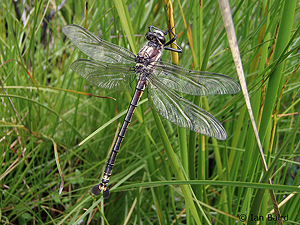
[⊗]
A male Petalura gigantea.
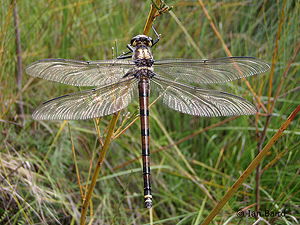
[⊗]
A female Petalura gigantea.
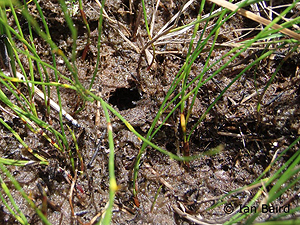
[⊗]
Burrow entrance.
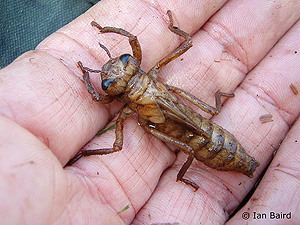
[⊗]
Larva.
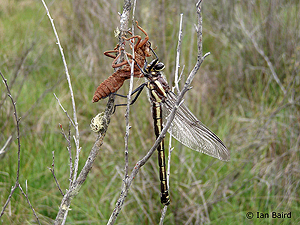
[⊗]
Newly emerged female with shed larval skin.
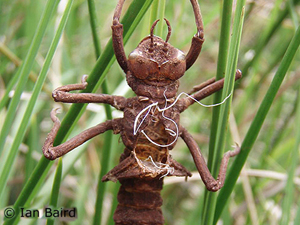
[⊗]
Larval skin (exuvia).
|

